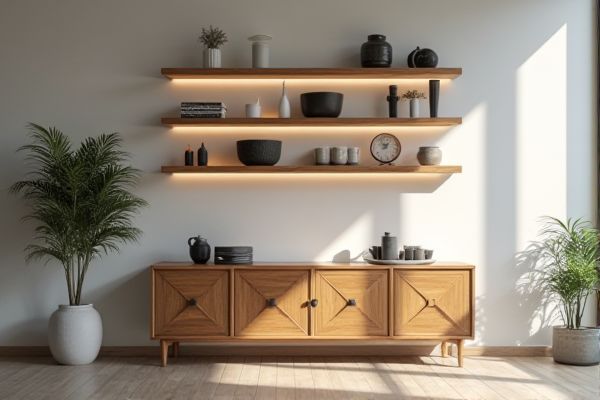
A display shelf offers open, elevated space ideal for showcasing decorative items or frequently used kitchenware, while a buffet top provides a broader, sturdier surface perfect for serving meals or holding larger dishes. Explore the article to determine which option best suits your space and style needs.
Table of Comparison
| Feature | Display Shelf | Buffet Top |
|---|---|---|
| Primary Use | Showcasing decorative items, photos, and collectibles | Serving and storing food items during meals or gatherings |
| Location | Living rooms, hallways, or display areas | Dining rooms or kitchens |
| Design | Open shelves, often wall-mounted | Flat surface on a buffet cabinet or sideboard |
| Storage | Minimal; mainly for display | Additional storage below for dishes, utensils, linens |
| Material | Wood, metal, glass | Wood, stone tops, or composite materials |
| Height | Varies; typically eye-level | Standard countertop height (~36 inches) |
| Functionality | Decorative, light-duty display | Practical for serving and extra workspace |
Introduction: Display Shelf vs Buffet Top
Display shelves and buffet tops serve distinct but complementary roles in home organization and interior design, with display shelves primarily used to showcase decorative items, collectibles, or frequently used kitchenware in an accessible and visually appealing manner. Buffet tops, found on sideboards or buffets, offer a sturdy surface designed for serving food during gatherings or for additional countertop space in dining areas. Your choice between the two depends on whether you prioritize open display and aesthetics or functional serving and storage space.
Defining Display Shelves
Display shelves are wall-mounted or freestanding units designed specifically to showcase decorative items, collectibles, or frequently used objects with easy visibility and access. Unlike buffet tops, which serve as flat surfaces atop sideboards or buffets primarily for serving or temporary placement, display shelves emphasize aesthetics and organization, often featuring open designs or glass fronts. Their construction materials range from wood and metal to glass, tailored to enhance room decor while maximizing functional display space.
What is a Buffet Top?
A buffet top is the upper section of a buffet cabinet, designed to provide additional display space above the storage base, often featuring shelves or glass doors for showcasing decorative items or fine china. Unlike a display shelf, which is typically a standalone unit mounted on a wall, a buffet top integrates with the buffet's structure to combine functionality and aesthetics in dining room furniture. Your choice between a display shelf and a buffet top depends on the need for enclosed storage versus open, elevated display space.
Design and Aesthetic Differences
Display shelves feature open structures ideal for showcasing decorative items, offering a light and airy aesthetic that enhances room visibility. Buffet tops typically have solid, flat surfaces designed for serving and storage, contributing to a more substantial and grounded visual impact. Your choice depends on whether you prefer the elegance of exposed display or the functionality and classic look of a buffet top.
Functional Comparison
A display shelf offers open storage that enhances visibility and easy access to decorative items, while a buffet top provides a flat, sturdy surface ideal for serving food and organizing dining essentials. Display shelves prioritize showcasing collectibles, making them perfect for personalization, whereas buffet tops emphasize functionality in dining settings by supporting plates, napkins, and utensils. Selecting between the two depends on whether your priority is visual display or practical serving space.
Space Utilization and Storage Capacity
Display shelves maximize vertical space by offering open storage for decorative items, making them ideal for small areas where showcasing is prioritized over hidden storage. Buffet tops provide a broader surface area coupled with enclosed cabinets or drawers underneath, enhancing your storage capacity for dining essentials while maintaining accessible countertop space. Choosing between them depends on whether you need more visible display options or substantial concealed storage to optimize your room's functionality.
Materials and Durability
Display shelves are commonly made from materials like engineered wood, metal, or glass, offering a balance between aesthetic appeal and lightweight durability ideal for showcasing items. Buffet tops typically utilize solid hardwood or stone surfaces such as granite or marble, providing greater durability and resistance to scratches or heat for frequent use in dining areas. Choosing the right material ensures Your furniture withstands daily wear while complementing your interior design.
Best Uses and Placement in the Home
Display shelves are ideal for showcasing decorative items, books, or collectibles in living rooms, kitchens, or hallways where visibility is key, providing open storage that enhances room aesthetics. Buffet tops are best suited for dining rooms or kitchen areas, offering a sturdy surface for serving food, placing appliances, or organizing dinnerware within easy reach. Placement depends on function: display shelves work well mounted on walls or as standalone units to highlight decor, while buffet tops are typically placed against walls near dining tables for convenience and practicality.
Maintenance and Cleaning Tips
Display shelves require regular dusting and occasional wiping with a damp cloth to maintain their appearance, as their open design tends to collect dust more quickly. Buffet tops, often used for serving or as a workspace, benefit from thorough cleaning after each use with mild soap and water to prevent stains and food residue buildup. You can preserve both by avoiding harsh chemicals and using protective liners or mats on buffet tops to minimize scratches and spills.
Choosing the Right Option for Your Needs
Choosing between a display shelf and a buffet top depends on your storage and aesthetic needs; display shelves offer open, accessible spaces ideal for showcasing decorative items, while buffet tops provide a flat, sturdy surface perfect for serving or organizing. Consider the available space, usage frequency, and desired visual appeal to select the best option for dining rooms or living areas. Incorporating materials like wood, glass, or metal can further tailor functionality and style to complement your existing decor.
 homyna.com
homyna.com